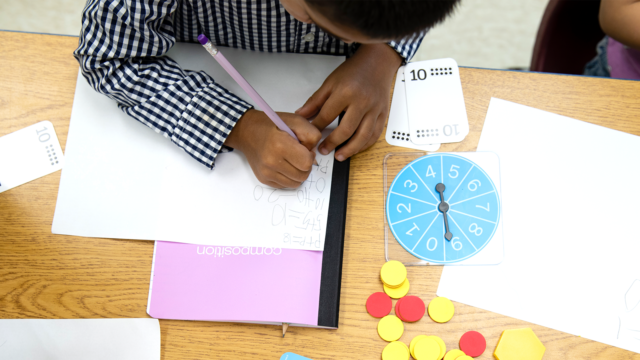
It is no doubt impossible for me to solve the complex, contextual problem of how you should teach your middle school students in a single blog post. You, and you alone, are the only expert on what it takes to teach your students in your school and community. However, teaching—like all jobs—is one where there are always new ideas to explore and fundamentals to practice.
Approaches to How to Teach Middle School Math
Teaching math at the middle school level is very different from the elementary school level. Middle school math teachers are generally not expected to also help students with other subjects, though of course one cannot fully separate math from other disciplines.
At the middle school level, just by virtue of being older, math students are further along in their mathematical development. This means your mathematical conversations can be more rigorous and substantive. But this also means skill gaps can be harder to fill. It is a time of transition, both for the students who are at a difficult age and for the math content itself, which transitions from the intuitive rules of arithmetic to the abstract mind-warp of algebra.
Differentiating Middle School Math Instruction
There are different schools of thought as to what differentiation in middle school math means. Some educators equate differentiation with tiered math centers. Other educators think about differentiation in terms of catering to students’ different learning styles. However, we caution against the common myth that learners are segmented into “visual,” “auditory,” and “kinesthetic.” Regardless of the outlook, educators can agree that differentiation is about addressing the diversity of skills that any classroom presents.
Veteran math educators Marian Small and Amy Lin point out a trap that befalls many middle school teachers. It is not realistic for teachers to create a different instructional path for every student. Because this is commonly perceived as the alternative to one-size-fits-all teaching, instruction in secondary mathematics is sometimes not differentiated at all.
At HMH, differentiation is multifaceted. It includes providing students with choice in their learning and a voice in any classroom conversation, along with tiered math centers, digital activities, and tools to teach one concept in multiple ways. Differentiation in middle school is far deeper than making sure images have sounds and movement to go along with them. It means finding entry points for students who feel left out, providing activities with low floors and high ceilings (and wide walls), and facilitating discourse among every student.
Strategies for Differentiated Instruction
1: Open Questions
Too often, math is approached as a series of questions that have either right or wrong answers. This does not need to be how math is taught! Contrast the following two problems:
- Does the equation 3x + y = 0 describe a proportional relationship?
- Draw the graph of 3x + y = 0. What do you notice, and what do you wonder?
Both problems practice similar concepts and open the door to similar discourse. However, the first problem leads to a “yes/no” answer that can be daunting if you don’t know how to solve it and end the learning prematurely if you do.
In general, ask questions that have a variety of responses or approaches. The goal is for every student to be able to participate in the learning conversation. You can try these techniques to make a question more open:
- Instead of asking for an answer, provide an answer and ask for a question.
- Ask students about what they notice and wonder.
- Ask for similarities and differences.
- Remove numbers from the statement.
- Ask for written responses.
In general, be mindful of how much ambiguity is in the question. The goal is to facilitate a rich conversation among students, but you don’t want it to go off track from the topic you intend to teach. Contrast the vague—though potentially interesting—question “What is a number?” with the more targeted, yet still open, question, “How do you know whether a number is divisible by 50?”
2: Choice Boards
In our post on introductory strategies for differentiated math instruction, we explain that a choice board is a graphic organizer that gives students activities to choose from. They are customizable and can focus entirely on one math topic or provide a wide range of activities that extend even beyond math. The idea is you lay out different learning options for the students and give them control over which options they pursue.
Choice boards have a few key attributes to help you differentiate instruction. They give students agency over their learning—an important way to build motivation and help students complete tasks they feel confident they can succeed in. They let you introduce a range of contexts and topics into the lesson so that you can reach multiple students at once. Choice boards also offer a way to structure learning when it needs to be done in a remote or hybrid environment.
We developed a choice board for remote learning that covers all subjects but also includes a free template to get you started on a math-only version. Consider activities like the ones below as engaging open-ended activities for middle school math students. It may help to list the activities on a separate document with labels like "Percent in the News" or "Activity 1" so the choice board itself doesn’t require too much text.
- Find an example of a percent in a news article. What is the part? What is the whole? In this situation, is this a high or low percent, and why?
- Propose a theory about when something is most likely to occur, for example, “I see the most birds outside my window around 10:00 am.” Make observations to test your theory and graph what you observe. Do your observations support your theory?
- Cut a sheet of paper so it’s a square that’s exactly 8.5 inches along each side. How can you cut and fold it to contain the greatest possible volume? Explain your process.

3: Math Exit Tickets
It’s possible you already have a wealth of resources to give your students but instead need support figuring out what to give to whom. Math exit tickets are a popular and effective way to accomplish this before moving on to the next concept. They are short problems (less than 5 minutes) that the entire class responds to, and then you can adjust instruction based on their responses.
Exit tickets can be implemented flexibly. They are most commonly used at the end of a lesson to gauge whether your students understood the topic being taught. You can also check in on student progress quickly at the end of one lesson to figure out what to teach during the next one. Exit tickets can alternatively be used at times other than when students are “exiting” the classroom to provide you with a snapshot of who already knows an upcoming topic or who has mastered certain prerequisite topics.

- Download Math Exit Ticket (Grades 1–2, addition)
- Download Math Exit Ticket (Grades 3–4, finding quotients)
- Download Math Exit Ticket (Grades 3–4, distributive property)
- Download Math Exit Ticket (Grades 5–6, evaluate an expression)
4: Metacognitive Strategies
Research has shown that if you can get students to reflect critically on their mathematical thinking, you can nurture their opportunities to grow. On the surface, students’ struggles may seem to come from math concepts, but the deeper problem may in fact be their mindsets.
As we discussed in our article on math intervention strategies, seek out lessons that specifically focus on metacognition. Math 180 mindset lessons, for example, invite useful class-wide discourse around questions without right or wrong answers, such as “do you believe you’re a math person?” Everyone in the class can find an entry point into a discussion that isn’t dependent on math skills—and it can help narrow the achievement gap among your students in the long term.
When conducting a discussion around students’ mathematical thinking, have them share their math stories. What was math like in their household and in previous classes? Ask students how they feel about math, and have them reflect on what they say. Are they thinking thoughts like “I’ll never get this” or “There’s nothing I can do about it?” Present ways to combat this thinking, such as taking a break, asking for help, or brainstorming a new strategy.
5: Parallel Tasks
Instead of giving the class one problem to work on, try giving two problems. Pose two different questions at different levels but connected by the context and big idea to which they relate. When done right, the questions themselves will suit the needs of different students, but the entire class can participate in a discussion. Consider these two tasks:
- What real life situation might the number 1,000 describe?
- What real life situation might the number 38,257.129 describe?
Notice here how differentiated instruction is not the same as more instruction. Rather, the instruction covers the same students and amount of time, but it is presented strategically and allows you to meet students’ different needs simultaneously. It empowers you to teach more equitably and provide greater access.
6: Academic Competitions
This article begins with the reality that no two classrooms are alike. Your classroom may include some learners who perform above grade level and potentially thrived on virtual learning. These students are likely ready to explore mathematics far beyond the core curriculum. Academic competitions such as the Mathematical Olympiads for Elementary and Middle Schools or Math Kangaroo offer a way to support this category of student.
Math competitions create a melting pot of the mathematically curious—students who are already starting to become tomorrow’s scientists, technologists, and engineers. Math competitions differentiate instruction along multiple axes. They engage students in challenging higher-order thinking. They bring budding mathematicians together—even if it's virtual—creating a community rooted in their learning. Plus, they expose students to a breadth of math topics that students will like, dislike, and disagree on. Imagine your middle school students debating topics like these:
- Is “infinity plus one” bigger than infinity?
- How would you measure coolness?
- What’s the optimal way to solve a puzzle from a specific video game level?
No matter your students’ skills and interests, there is always a way to get them engaging with mathematics with choice in how they progress and exercising their voice along the way. Hopefully, these math strategies for middle school students give you a way to get started.
***
HMH offers a variety of math classroom solutions to help you reach every student. Just looking for more instructional strategies for middle school math? Try one of the articles below to keep reading!

Explore the challenges of differentiated instruction and how technology can help. Using technology to differentiate instruction assists in automating the process.

These strategies provide differentiated math instruction to K-12 teachers looking for ways to personalize their mathematics teaching.
Get free strategies to personalize whole-group instruction in your classroom.














